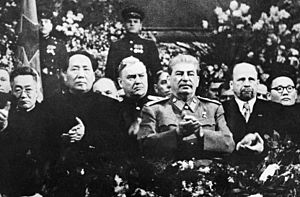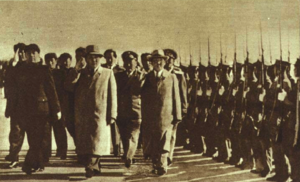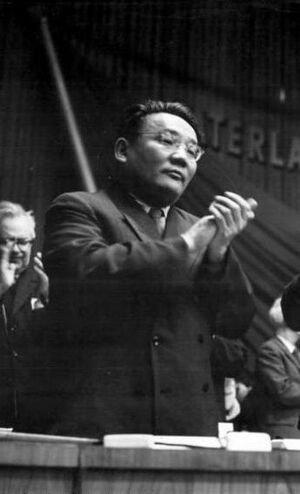Yumjaagiin Tsedenbal facts for kids
Quick facts for kids
Yumjaagiin Tsedenbal
Юмжаагийн Цэдэнбал ᠶᠠᠭᠤᠮᠠᠵᠢᠭᠠ ᠶᠢᠨ ᠼᠡᠳᠡᠨᠪᠠᠯ |
|
|---|---|
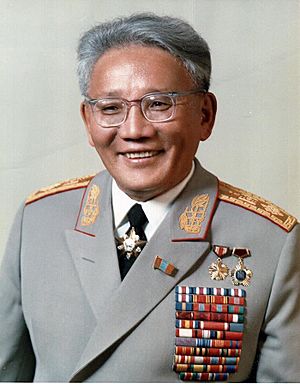
Tsedenbal in the 1970s
|
|
| Chairman of the Presidium of the People's Great Khural | |
| In office 11 June 1974 – 23 August 1984 |
|
| Preceded by | Sonomyn Luvsan (acting) |
| Succeeded by | Nyamyn Jagvaral (acting) |
| 11th Chairman of the Council of Ministers | |
| In office 26 January 1952 – 11 June 1974 |
|
| Preceded by | Khorloogiin Choibalsan |
| Succeeded by | Jambyn Batmönkh |
| General Secretary of the Mongolian People's Revolutionary Party | |
| In office 22 November 1958 – 24 August 1984 |
|
| Preceded by | Dashiin Damba |
| Succeeded by | Jambyn Batmönkh |
| In office 8 April 1940 – 4 April 1954 |
|
| Preceded by | Dashiin Damba |
| Succeeded by | Dashiin Damba |
| Personal details | |
| Born | 17 September 1916 Davst sum, Uvs aimag, Outer Mongolia |
| Died | 20 April 1991 (aged 74) Moscow, Russian SFSR, Soviet Union |
| Resting place | Altan-Ölgii National Cemetery |
| Political party | Mongolian People's Revolutionary Party (1936-1984) |
| Spouse | Anastasia Filatova |
| Children | Vladislav Zorig |
| Residence | Ikh Tenger Complex |
| Website | https://tsedenbal.mn/ |
| Nickname | Бал дарга ("Chief Bal") |
| Military service | |
| Allegiance | |
| Branch/service | |
| Years of service | 1936-1984 |
| Rank | |
Yumjaagiin Tsedenbal (Mongolian: Юмжаагийн Цэдэнбал; 17 September 1916 – 20 April 1991) was a very important leader of the Mongolian People's Republic. He led the country for over 30 years, from 1952 to 1984.
During his time as leader, he held several key positions. He was the head of state, the head of government (like a prime minister), and the leader of the main political party. He was the longest-serving leader in any country that was part of the Eastern Bloc.
Contents
Early Life and Education
Tsedenbal was born on September 17, 1916. His family was nomadic and not wealthy. He was the fifth of eleven children.
In 1925, Tsedenbal was one of the first students at a new public school in Ulaangom. After finishing there in 1929, he went to Russia to continue his studies. He spent about nine years in Irkutsk and Ulan-Ude. There, he learned the Russian language and earned a degree in finance and economics.
Starting His Political Career
After returning to Ulan Bator in 1939, Tsedenbal quickly rose in government. He worked as a deputy minister and then became the Minister of Finance from 1939 to 1940. He also served as the governor of the Bank of Mongolia.
In 1940, at just 23 years old, he became the General Secretary of the Mongolian People's Revolutionary Party. This was a very important leadership role. He held this position again starting in 1958.
Becoming Mongolia's Leader
After the death of Marshal Khorloogiin Choibalsan in 1952, Tsedenbal took over the main leadership role. He became the Chairman of the Council of Ministers.
Later, on June 11, 1974, he became the head of state, known as the Chairman of the Presidium of the People's Great Khural. This made him the supreme ruler of the Mongolian People's Republic.
Important Policies and Decisions
Foreign Relations
Tsedenbal's foreign policy focused on making Mongolia very close to the Soviet Union. He wanted to develop Mongolia's industries, even though the Soviets preferred Mongolia to focus on farming and mining.
Relations with the Soviet Union
Tsedenbal always showed loyalty to the Soviet leaders. He even asked several times for Mongolia to become part of the Soviet Union, but these requests were always turned down.
In 1966, a special treaty was signed between the Soviet Union and Mongolia. This allowed Soviet troops to be stationed in Mongolia for defense. This was the first time foreign troops were based in the country.
Relations with China
At the beginning of his rule, Tsedenbal tried to have good relations with China. However, when the Soviet Union and China had disagreements, Tsedenbal strongly supported the Soviet Union. This made China very angry.
Despite the tensions, Mongolia and China signed a border treaty in 1962. In the early 1960s, Tsedenbal ordered all Chinese citizens to leave Mongolia.
Relations with Other Countries
- In 1956, he welcomed North Korean leader Kim Il-Sung to Mongolia.
- He supported North Korea's goal of uniting Korea peacefully.
- During the Vietnam War, he supported the Soviet Union's position.
- Mongolia joined the United Nations in 1961.
- Under Tsedenbal, Mongolia also started diplomatic ties with West Germany in 1974.
- He visited New Delhi, India, in 1973 and signed a joint agreement with Indira Gandhi. He also supported India during the 1971 war that led to the creation of Bangladesh.
Views on Joining the USSR
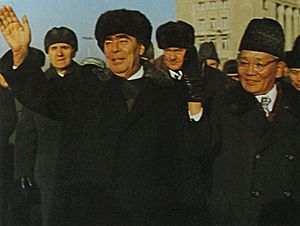
For a long time, Tsedenbal was a strong supporter of Mongolia joining the Soviet Union. He even asked for this several times.
However, in his later years, his views changed. His son, Zorig, said that Tsedenbal once discussed this with Soviet leader Leonid Brezhnev. Tsedenbal told Brezhnev that Mongolia was ready to cooperate fully with the Soviet Union in all areas, but only if Mongolia remained an independent country.
How Tsedenbal Left Power
Tsedenbal was forced to retire in August 1984. This decision was supported by the Soviet Union. The official reason given was his old age and health. However, it was also partly because he did not agree with the Soviet Union trying to improve its relationship with China.
Jambyn Batmönkh became the new leader of the party. Tsedenbal was removed from power just before a big ceremony celebrating a Soviet-Mongolian victory.
Later Life and Death
After leaving power, Tsedenbal stayed in Moscow, Russia. He tried to contact Mongolian officials, but no one visited him. In 1990, he lost his titles and awards from Mongolia.
He passed away on April 20, 1991, in a Moscow hospital. His body was brought back to Mongolia five days later. He was buried with military honors at the Altan-Ölgii National Cemetery.
In 1997, a new decree by President Punsalmaagiin Ochirbat restored Tsedenbal's titles and awards.
Tsedenbal's Legacy
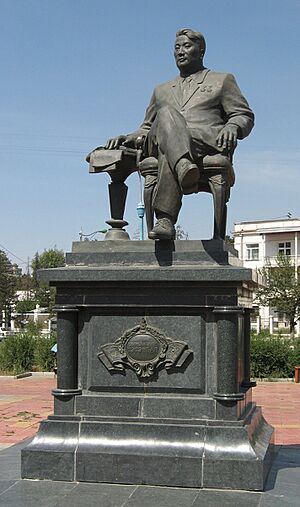
In Mongolia, Tsedenbal is remembered for keeping the country on a path of moderate socialism during the Cold War. A statue of him was built in 2000 in Ulaanbaatar. The square where the statue stands is now called Tsedenbal Square.
In 2016, the Erdenet Mining Corporation was named after him. In 2019, Mongolian filmmakers even made a movie about his life. His son, Zorig, also started the Tsedenbal Academy in Mongolia.
Personal Life
Tsedenbal was married to Anastasia Filatova, who was Russian. Many people believed she was very powerful in Mongolia because of her close friendship with Soviet leader Leonid Brezhnev.
They had two sons, Vladislav and Zorig. His granddaughter, Anastasia Tsedenbal, was born in 1985 and studied African research.
Images for kids
-
Tsedenbal with Bulgarian leader Todor Zhivkov and East German leader Erich Honecker in 1971.
See also
 In Spanish: Yumjaagiyn Tsedenbal para niños
In Spanish: Yumjaagiyn Tsedenbal para niños


